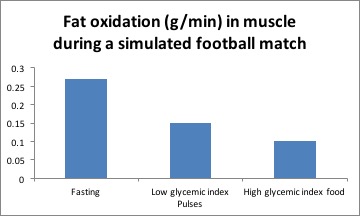Pulses (like lentils) can enhance performance, naturally. Will the International Year of Pulses raise the profile of this food with sports nutritionists?
Lentils, chickpeas, beans, and field peas are low-fat legumes called pulses that are being promoted as a “superfood” for athletes, because they are high in protein and low-glycemic index carbohydrates. Low-glycemic index carbohydrates are slowly digested, providing a sustained source of energy to muscle over several hours. Low-glycemic index carbohydrates are also beneficial because the slow digestion stimulates a lower release of insulin into the blood compared to carbohydrates with a higher-glycemic index such as white bread, mashed potatoes, or sugar-sweetened drinks such as Gatorade. A high insulin level in the blood prior to endurance exercise might be detrimental because insulin inhibits the burning of fats by muscle.
Pulses, with their low-glycemic index carbohydrate, allow greater stimulation of fat use in muscle compared to high-glycemic index carbohydrates. When pulses are consumed in the hours before endurance exercise (either whole or incorporated into sports nutrition bars) they improve metabolism during exercise (i.e. they promote the use of fats by muscle and preserve muscle glycogen – the carbohydrate stores in muscle that are important for extending endurance performance).
Studies run by me (supported by the Saskatchewan Pulse Growers and the Western Grains Research Foundation) at the University of Saskatchewan in Canada with the university soccer team suggest that Pulses consumed a couple of hours before a football match improved agility running performance in the late stages of the 90-minute match. When consumed by football players daily over a month, pulses reduce body fat percentage and allow players to run about 2.5% greater distance during their matches, as assessed by global positioning systems. This improvement in running distance is substantial enough to improve on-field football performance. Lentils, beans, chickpeas, and peas are not only beneficial for performance, but also have benefits for health because they reduce cholesterol levels; high cholesterol levels are a risk factor for long-term development of heart disease.
Often high-glycemic index carbohydrates are recommended during recovery from exercise because they promote a faster glycogen replenishment in muscle; however, pulses consumed after exercise stimulate the continued use of fats in muscle and the high protein content may stimulate repair of damaged muscle and synthesis of muscle proteins. When pulses are compared to high-glycemic index carbohydrates during recovery from exercise, they are equally as effective and sometimes more effective for improving next-day exercise performance (i.e. time trial performance in cyclists, agility time and time to complete a ball-dribbling course in football players).
In summary, pulses are an emerging ‘superfood’ that has potential to improve performance, body composition, and long-term health of endurance athletes. But we can do more to analyse the potential benefits of pulses on athlete performance, which is why I am currently running further ‘pulse’ studies in soccer, using GPS devices to better track the impact of pulses on performance. I would like to extend the research to involve other sports, especially rugby union, so if anyone reading this from that sport wishes to get in touch please contact me at the address below.
Prof. Phil Chilibeck This email address is being protected from spambots. You need JavaScript enabled to view it.

* High-glycemic index carbohydrates consumed before a simulated football match impaired fat use by muscles; whereas low-glycemic index pulses did not (from Little et al. International Journal of Sports Physiology and Performance, 2009).
* Low-glycemic index pulses consumed before a simulated football match reduced carbohydrate use by muscles. This is beneficial because it allows greater preservation of muscle carbohydrate stores during exercise, which extends endurance performance (from Bennett et al. British Journal of Nutrition 2012).
